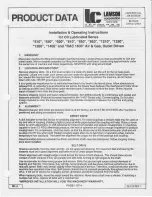
OPERATION
15
en
FUEL RECOMMENDATIONS
Fuel must meet these requirements:
•
Clean, fresh, unleaded gasoline.
•
A minimum of 87 octane/87 AKI (91 RON). High altitude use,
see below.
•
Gasoline with up to 10% ethanol (gasohol) or up to 15%
MTBE (methyl tertiary butyl ether) is acceptable.
NOTICE: Do not use unapproved gasolines, such as E85. Do
not mix oil in gasoline or modify the engine to run on
alternate fuels. This will damage the engine components
and void the engine warranty.
To protect the fuel system from gum formation, mix a fuel stabilizer
into the fuel. All fuel is not the same. If starting or performance
problems occur, change fuel providers or change brands. This
engine is certified to operate on gasoline. The emissions control
system for this engine is EM (Engine Modifications).
High Altitude
At altitudes over 5,000 feet (1524 meters), a minimum
85 octane/85 AKI (89 RON) gasoline is acceptable. To remain
emissions compliant, high altitude adjustment is required.
Operation without this adjustment will cause decreased
performance, increased fuel consumption, and increased
emissions. See a Briggs & Stratton Authorized Dealer for high
altitude adjustment information.
Operation of the engine at altitudes below 2,500 feet (762 meters)
with the high altitude kit is not recommended.
ADDING FUEL
1. Clean the fuel cap area of dirt and debris. Remove the fuel
cap (
G
, Figure 3).
2. Fill the fuel tank with fuel. To allow for expansion of the fuel,
do not fill above the bottom of the fuel tank neck.
3. Reinstall the fuel cap.
WARNING:
Fuel and its vapors are extremely flammable and
explosive.
Fire or explosion can cause severe burns or death.
When Adding Fuel
• Turn engine off and let engine cool at least 3 minutes before
removing the fuel cap.
• Fill fuel tank outdoors or in well-ventilated area.
• Do not overfill fuel tank. To allow for expansion of the fuel, do not
fill above the bottom of the fuel tank neck.
• Keep fuel away from sparks, open flames, pilot lights, heat, and
other ignition sources.
• Check fuel lines, tank, cap, and fittings frequently for cracks or
leaks. Replace if necessary.
• If fuel spills, wait until it evaporates before starting engine.
Not
for
Reproduction
Summary of Contents for 1695821
Page 2: ...2 www simplicitymfg com N o t f o r R e p r o d u c t i o n...
Page 26: ...N o t f o r R e p r o d u c t i o n...
Page 27: ...27 en N o t f o r R e p r o d u c t i o n...
Page 52: ...N o t f o r R e p r o d u c t i o n...
Page 53: ...27 fr N o t f o r R e p r o d u c t i o n...
















































